Physical Address
304 North Cardinal St.
Dorchester Center, MA 02124
An acute inflammatory process involving leptomeninges and cerebrospinal fluid
Approximately 2.5/100,000 (United States) each year
Hematogenous spread most common
Pneumonia with bacteremia
Other routes
Direct inoculation (trauma, procedures)
Invasion (sinusitis, mastoiditis, oral infections)
Birth to 1 month: Streptococcus pneumoniae, E. coli, Listeria monocytogenes
1 month to 29 years: Neisseria meningitidis > Streptococcus pneumoniae
Haemophilus influenzae (now less common because of vaccine)
30 years to elderly: Streptococcus pneumoniae > Neisseria meningitidis > Listeria monocytogenes
Risk factors
Liver disease
Hemoglobinopathies
Immunodeficiency/debilitated states
Meningococcal meningitis: asymptomatic nasopharyngeal carriers; close personal contact
Typically late winter epidemics
Dormitories, barracks, daycare centers
Sometimes mistaken for flu/pharyngitis
Onset: hours to days
Classic triad—99% to 100% will have at least one :
Fever
Altered mental status
Nuchal rigidity
Less common:
Photophobia
Nausea/vomiting
Seizures
Focal neuro deficits
Elderly may have atypical presentations
Nonspecific neurologic findings
Normal/low temperature
Meningococcal meningitis: classic triad plus rash (may be petechial, purpuric, maculopapular), myalgias, arthritis
Waterhouse-Friderichsen syndrome
Septicemia
Shock
Disseminated intravascular coagulation with purpura
Bilateral adrenal hemorrhage
CSF
Leukocytosis (neutrophilia)
Elevated protein
Low glucose
Treatment: empiric antibiotics, corticosteroids
Mortality rate
Nosocomial (35%)
Community acquired (25%)
Highest mortality
Pneumococcus
Listeria
Neurologic sequelae
Cognitive changes; cranial nerve deficits (hearing loss)
Seizures
Hydrocephalus
Vascular abnormalities
MRI: T1 with contrast: leptomeningeal enhancement
Early: mild edema, vascular congestion
May be only finding if rapidly fatal; especially meningococcal, pneumococcal disease
Late
Subarachnoid fibrinopurulent exudate
Hydrocephalus
Petechial hemorrhages
Subarachnoid polymorphonuclear neutrophilic infiltration with variable fibrin deposition
Eosinophilic protein stranding
Vessel thrombosis
Ependymitis
Cortical infarcts
GMS (Gomori methenamine silver), AFB (acid-fast bacilli), Gram (bacteria)
Mycobacterial/fungal/viral/chemical meningoencephalitis
Rickettsial infections
Subarachnoid hemorrhage
Drug reaction
Carcinomatosis
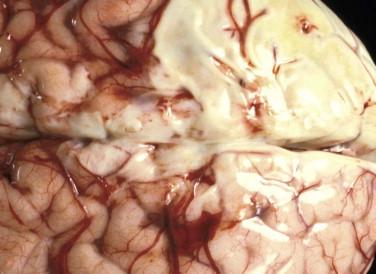
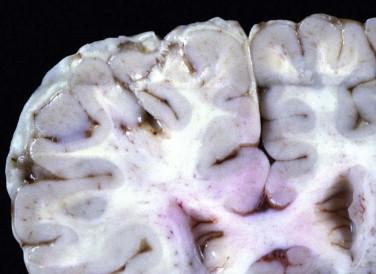
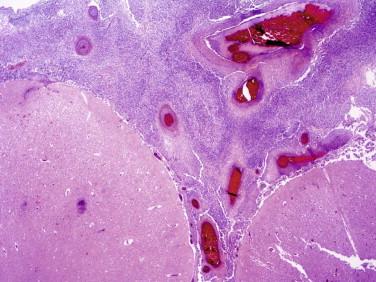
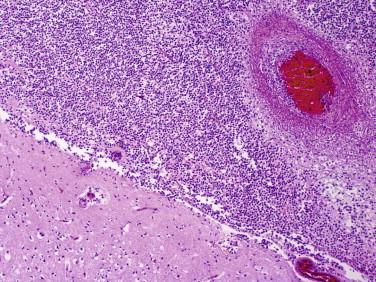
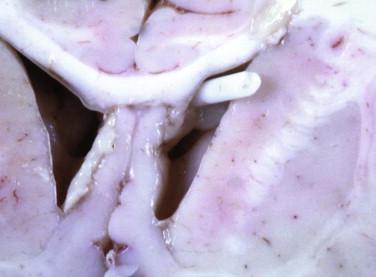
A cavitary lesion within CNS parenchyma containing purulent material; fully developed lesion has fibrocollagenous wall
Affects 0.3 to 1.3/100,000 people per year, most commonly age 30 to 50 years
Male/female ratio: 2 to 4:1
Extension of local infection in head and neck (most common)
Hematogenous spread
Pulmonary abscess, bronchiectasis, periodontal disease
Direct inoculation
Penetrating trauma; iatrogenic
Increased incidence
Pulmonary arteriovenous malformations
Immunocompromised patient
Cyanotic heart disease
Endocarditis
Sinusitis, otitis media (likely via retrograde thrombophlebitis)
Pathogens
Anaerobic or microaerophilic streptococci: S. milleri group—most common
Staphylococci: S. aureus— most common with trauma/craniotomy
Aerobic gram-negative bacilli (e.g., Proteus, Bacteroides )
Actinomyces/Nocardia
Fungi (immunocompromised): Aspergillus, Cryptococcus, Candida, Mucor
Listeria (associated with glucocorticoid use)
Mycobacteria or parasites (travelers/immigrants): neurocysticercosis (e.g., Toxoplasma, Entamoeba, Schistosoma japonicum, Paragonimus )
Insidious onset: localized headache (primary symptom); fever (<50% cases)
Increasing perilesional edema may lead to focal neurologic deficits, seizures, deteriorating mental status
CSF findings uncommon unless ventricular involvement
With antibiotics
Mortality rate ~10% (without ventriculitis)
Neurologic deficits may develop because of associated destruction of CNS tissue
MRI: T1 postcontrast ring-enhancing lesion(s) with significant perilesional edema
Become a Clinical Tree membership for Full access and enjoy Unlimited articles
If you are a member. Log in here